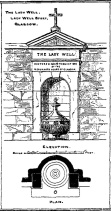Holy Well: OS Grid Reference – NS 60376 65323
Also Known as:
Get yourself to Glasgow Cathedral—wherein you’ll find St. Mungo’s Well—and walk down John Know Street. A coupla hundred yards down, across the road is a small street called Ladywell Lane (there’s no signpost for it though), running below the cemetery and leading to the back entrance of the giant Tennent’s Brewery. At the bottom of this, up against the wall on your left, is the Lady Well.
Archaeology & History
The origins and early traditional history of this once famous sacred well are sadly lost due to the intrusion of industrialism. It was obviously a place of some considerable repute and lent its name to local quarries and fields hereby. Used extensively by local people for countless centuries, things were to change in 1715 when the waters of this and other wells were to be kept clean by one John Black, “at a salary of 400 merks yearly.” The Glasgow historian Eyre-Todd (1934) told that,
“Black was to furnish them with chains, buckets, sheaves, ladles, and other necessary graith, aswell as with locks and iron bands. He was ‘to cleanse, muck and keep them clean,’ and to lock and open them in due time, evening and morning. In case of failure he was liable to a penalty of £100 Scots.”
That’s a helluva lot of money in those days! Even when M’Ure (1736) described it, only in passing, he had nothing to say about its curative properties or local rites. Once the Industrialists take control, the ways of local people are sanitized, sterilized and ‘progress’ outlaws tradition. The only reference to an earlier sacrality is in Mr Russel’s (1883) article, where he said simply, that the Lady Well was “so called after a fountain at the bottom of the Craigs…sacred in Popish times to the Virgin.”
The construction that we see today—of the well in its little enclave—was first built in 1835-6. The waters became polluted after they were redirected below the Necropolis and have not been used since (although they still flow out of the wall a couple of yards to the right, stinking!). The architectural feature was cleaned up and restored by the local brewery in 1983.
The site may have gained its name from one Lady Lochow, who lived nearby and built a hospital at the old Gorbels in the 14th century—but we might never know the real truth about the origin of its dedication. However, an intriguing ingredient relating to the dedication of the Lady Well is the incidence of a St. Anne’s Street that used to exist immediately to the east, as seen on the 1865 OS-map above. St. Anne may well be the mythic character behind the naming of this Lady Well, although I can find no literature to prove this. In the christian mythos, St. Anne was a very important character indeed: the mother of the Virgin Mary no less! However, as hagiographers from Attwater (1965), to Baring-Gould (1898) and Butler (1866) all tell, her biography is piecemeal—which is most surprising considering she was JC’s granny! Anne’s festival date was July 26 (a couple of days after Sirius enters the northern hemisphere); she was the patron saint of midwives, grandmothers and also miners, who invoked her as the deity who produced gold and silver—akin to the Earth Mother Herself! It’s obvious that Anne’s original mythic nature was subdued, as she represented an archaic root of matriarchal triplicity of the Virgin, the Lady and Old Woman and not the patriarchal triplicity of the incoming christian cult. The christian mythos at this Lady Well (as elsewhere) replaced one facet of the indigenous prima mater in Glasgow, known as the Cailleach—as shown in her attributes of midwife, grandmother and the deep Earth. If local historians can find field-names or wells dedicated to the Maiden, the Lady and the Carlin (or their variant titles) nearby, the lost layers of archaic Glasgow’s indigenous animistic folk memories could be mapped out once again…
References:
- Attwater, Donald, The Penguin Dictionary of Saints, Penguin: Harmondsworth 1965.
- Baring-Gould, S., The Lives of the Saints – volume 8, J.C. Nimmo: London 1898.
- Bennett, Paul, Ancient and Holy Wells of Glasgow, TNA 2017.
- Brotchie, T.C.F., “Holy Wells in and Around Glasgow,” in Old Glasgow Club Transactions, volume 4, 1920.
- Butler, Alba, The Lives of the Fathers, Martyrs and other Principal Saints – volume 7, James Duffy: Dublin 1866.
- Eyre-Todd, George, History of Glasgow – volume 3, Jackson: Glasgow 1934.
- Greene, E.A., Saints and their Symbols, Sampson Low: London 1897.
- MacIntosh, Hugh, The Origin and History of Glasgow Streets, James Hedderwick: Glasgow 1902.
- M’Ure, John, History of Glasgow, D. MacVean: Glasgow 1736.
- Walker, J. Russel, “‘Holy Wells’ in Scotland,” in Proceedings of the Society of Antiquaries of Scotland, vol.17 (New Series, volume 5), 1883.
© Paul Bennett, The Northern Antiquarian


